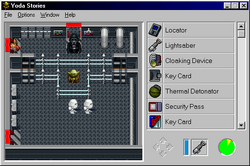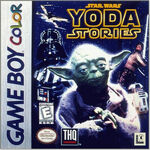Warning: This infobox has missing parameters: composer, programmer, producer, upc, prev, director, designer, next, writer, expansions, artist, closed, basegame, release date, series and unrecognized parameters: released, era Star Wars: Yoda Stories is a 1997 computer game based on the Star Wars franchise developed by LucasArts. It was preceded by Indiana Jones and His Desktop Adventures, and no further Desktop Adventures titles were released. In the Star Wars timeline, Yoda Stories is placed between Star Wars: Episode V The Empire Strikes Back and Star Wars: Episode VI Return of the Jedi, where Luke Skywalker is completing his training with Jedi Master Yoda.
Plot summary
- "Well Done, Luke! Taken another step you have... along the path that never ends!"
- ―Yoda, to Luke Skywalker
Unlike other titles, Yoda Stories has no central plot or definitive goal—it's a mere collection of random games where the player, controlling Luke Skywalker, has to complete an objective like rescuing Han Solo or Princess Leia, obtain an object, or warn the Rebellion in several locations of the Star Wars universe like Neshtab, Tatooine, and the Forest moon of Endor.

Luke rescuing Yoda from Darth Vader and two snowtroopers.
Each game starts with Luke arriving at Dagobah in an X-wing. If the player is still a rookie, R2-D2 can be picked up and dropped anytime for hints. After finding Yoda, the Jedi Master gives Luke one assignment and one object that will be required to complete it, and the game begins. Each gameworld is composed by 100 screens, but how many are active can be set in the options. Although it's not required to complete the game, a locator provides information (such as the status of a puzzle) and a way to find out where the player is. It is always found in one of the eight screens surrounding the spaceport screen, usually found under a rock, inside a wrecked vehicle or with a person. To progress in the game, the player has to make errands, such as finding a key, or an object, until he reaches the final puzzle. The Force is also present, but in the beginning it must be obtained from the ghost of Obi-Wan Kenobi. It stops all enemies from moving, and is occasionally required to complete a puzzle.
There are several enemies, from Imperial stormtroopers and Tusken Raiders to animals, and all can be dealt accordingly with Luke's lightsaber, blasters or thermal detonators (that destroy any enemies in a 3-radius plus sign pattern). As Luke can also be hurt, there are several ways to replenish his health, from health kits and bacta canisters to plants.
In the fifth game, Luke battles Darth Vader, and if successful, the next game he starts with a green lightsaber instead of his father's blue; after 10, he starts with the Force (without the need to find the ghost of Obi-Wan), and finally, after 15 times, with a "Spirit Heart", which gives the player a second life. Unlike Indiana Jones and his Desktop Adventures, Yoda Stories keeps the number of games beaten and also the highest score.
Indiana Jones is featured as an easter egg in a mission, as a sequel to a mission in Desktop Adventures. His similarity to Han Solo is remarked upon.
Possible Scenarios
The order of missions, the planets' maps and other details are randomly chosen, but the goals and which planet a mission takes place on stays the same each time
Desert World
- Bakkah: Recover Sith Amulet
- Tozeer: Find and rescue C-3PO
- Halm: Retrieve an Adegan crystal
- Tatooine: Rescue Han Solo from Jabba the Hutt
- Tatooine: Release the impounded Millennium Falcon
Forest World
- Nibiru: Find and rescue Princess Leia
- Endor: Retrieve the Ewoks' Lantern of Sacred Light
- Varn: Sabotage Imperial Battlemoon
- Tarsa: Sabotage Imperial relay station
- Argavat: Recover your X-wing from forest world, travel to Agravat to retrieve Imperial Battle Code
Snow World
- Etorasp: Rescue General Marutz
- Thaldo: Stop an Imperial attack against a Rebel base
- Neshtab: Sabotage a secret Imperial factory (which seems to be producing Dark troopers)
- Lokondo: Find and rescue Yoda
- Unidentified planet: Find & destroy a cloning machine (Indiana Jones cameo appearance in this scenario)
Critical reaction
The game received poor reviews at the time of the release, mostly because it was decided to review it as a regular game, rather than a "quick break" game replacement to games like Solitaire or Hearts. The graphics are simple bitmaps and regular 32x32 icons, with few animations.
Versions of the game

Box art from Gameboy Color version
A Windows version was released in 1997. This version can be bought on disc now, but needs a download from the internet to get it to work on newer versions of Windows. The Windows version included a re-release of Star Wars: Making Magic.
The Game Boy Color version was released in 1999. Like the computer version, the gameplay is a number of simple quests, but the game consisted of a finite number of levels: fifteen. The graphics are not as detailed or colorful compared to the computer game due to the limitations of the Game Boy Color hardware, and controlling the main character is more difficult and less fluid in this version due to the lack of a mouse. Because of these factors and lackluster, repetitive gameplay, the game has received consistently low scores from several gaming sites; Gamespot cited it as "possibly the worst Star Wars game ever produced".
Appearances
| Characters | Organisms | Droid models | Events | Locations |
| Organizations and titles | Sentient species | Vehicles and vessels | Weapons and technology | Miscellanea |
Characters
|
Organisms
Droid models
Events
|
Locations
Organizations and titles
Sentient species
Vehicles and vessels
Weapons and technology
Miscellanea
